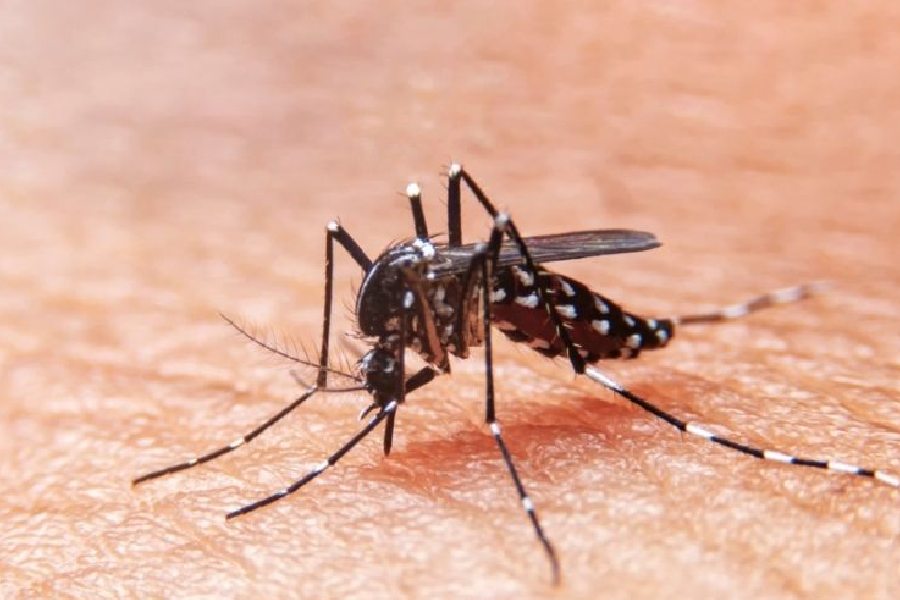Cleaning sewer lines and making door-to-door visits to detect mosquito-breeding sites — the civic bodies in Calcutta and Bidhannagar are taking measures to minimise chances of waterlogging and the spread of dengue.
The Telegraph lists what is being done in Calcutta and adjoining areas.
Sewer lines
From a thoroughfare in Gariahat to a narrow lane in Kasba, the Kolkata Municipal Corporation (KMC) is desilting manholes and gully pits.
“We clean manholes and gully pits through the year but the pace gathers momentum in the run-up to the monsoon,” said a KMC official.
The monsoon entered Calcutta on Friday.
The rainwater that gathers on a road is drained out through gully pits and enters the large sewer lines. If the gully pits are blocked with silt, the flow of the water into the main drainage channels is hindered.
A Ballygunge resident recently saw KMC men cleaning the sewer lines under Asutosh Chowdhury Avenue. On Sunday, a Kasba resident saw KMC men cleaning the sewer lines along a narrow lane near his home.
Officials said blocks in drains and gully pits were being removed before the monsoon showers start.
Similar initiatives are being taken in Bidhannagar and New Town. In the last few monsoons, New Town had suffered severe waterlogging despite being a planned township.
The road from BC Block to Pride Hotel in the township remained flooded for several hours following a downpour a fortnight ago. A stretch of the road near the Novotel Hotel intersection, too, went under water.
“The drainage channels and gully pits in several blocks and on roads that are prone to waterlogging have been cleaned,” said an official of the New Town Kolkata Development Authority (NKDA).
The drainage lines in several blocks in Salt Lake, including FD and EE, have been cleaned.
Debraj Chakraborty, the mayoral council member in charge of drainage and solid waste management of the Bidhannagar Municipal Corporation (BMC), said they have deployed multiple teams to clear the drainage networks and gully pits in the township.
Mosquitoes
The monsoon brings with it the threat of an outbreak of vector-borne diseases. Water that collects in any place and remains undisturbed for at least seven days can turn into a breeding site for the Aedes aegypti mosquitoes, which spread the dengue virus.
The KMC is focusing on destroying the breeding sites. Two-member teams have been formed in all wards and that going door to door to check possible mosquito-breeding sites.
“We have told our teams to check the ground floors and the terraces of standalone buildings and apartment complexes, which are the most common sites of mosquito breeding,” said an official.
The civic body is also conducting an awareness campaign — putting up banners, distributing leaflets and playing recorded messages — on how to prevent dengue.
“Vacant plots where people tend to throw waste are on our watch list,” said a KMC official.
“We have so far issued over 5,000 notices to owners of vacant plots and properties where mosquito larvae were found. Our teams have been visiting possible mosquito-breeding sites since the beginning of the year.”
The KMC has identified 64 wards in Calcutta that have a higher chance of a dengue outbreak. “We are focussing more on vector-control measures in these wards,” the official said.
BMC teams are making door-to-door visits in Salt Lake to check whether water is accumulating on the premises.
A senior civic official said they have found mosquito larvae in several houses. The residents have been asked to ensure that water does not accumulate on the rooftops and driveways and in garages.
On Sunday, The Telegraph spotted stagnant pools of water in several fountains in Salt Lake.
While five of them are in front of Central Park, three are on Broadway and two in AE and BE Blocks.
All had stagnant pools of water at their base.
Banibrata Banerjee, the mayoral council member in charge of the BMC’s health department, said: “We have just started the drive. Additional vector-control and solid waste management teams are on the ground. They have been instructed to remove garbage, drain out stagnant water and spray larvicide.”










